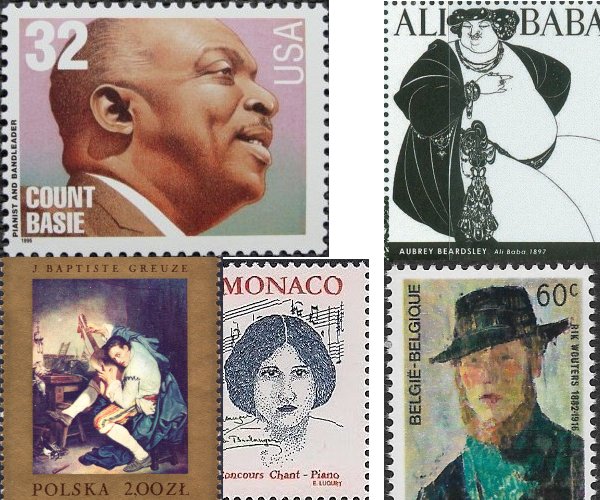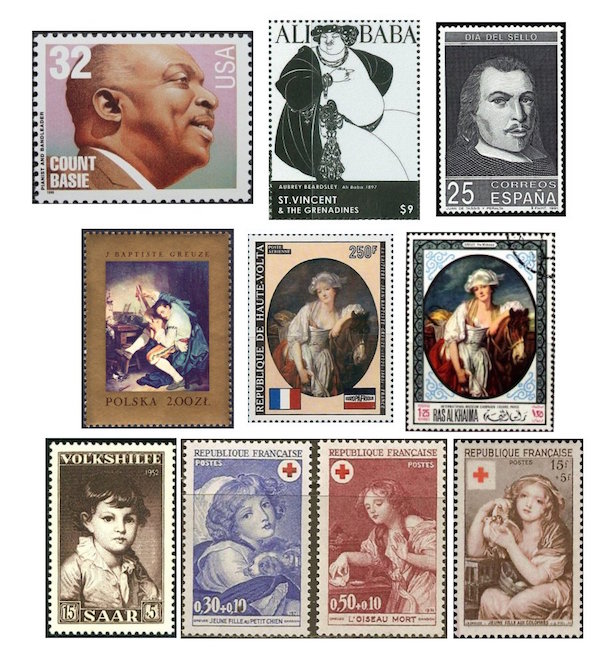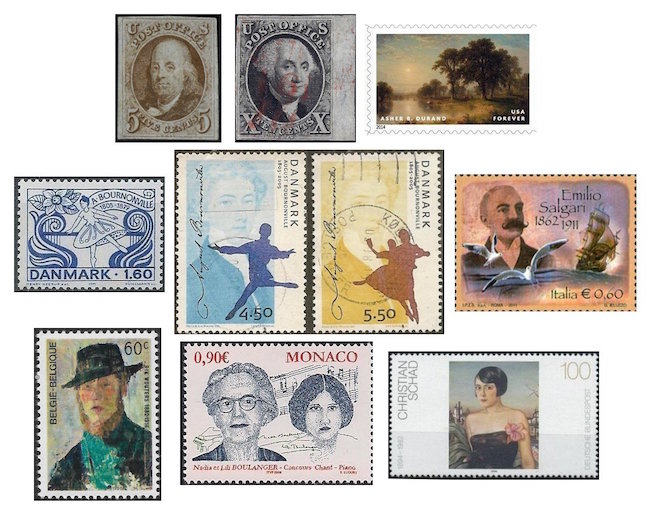The Arts on Stamps of the World — August 21
An Arts Fuse regular feature: the arts on stamps of the world.

By Doug Briscoe
An unlikely pair, Count Basie and Aubrey Beardsley, top our list of birthday subjects for this August 21st.
William James “Count” Basie (August 21, 1904 – April 26, 1984) learned piano from his mother, though he hoped for a time to be a drummer. He dropped out of school to work as a lighting operator in vaudeville and to accompany silent films with piano improvisations. Soon he was performing jazz. At twenty he went to Harlem and then began touring: St. Louis, New Orleans, Chicago. In Kansas City in 1929, Basie started playing with the Bennie Moten band and, on Moten’s death in 1935, created the Count Basie Orchestra, making his first recording with them in Chicago in 1936. He led the group for nearly half a century.
The short-lived English illustrator Aubrey Beardsley (21 August 1872 – 16 March 1898) also had his beginnings in music as an “infant musical phenomenon”. At school his first poems and drawings were printed in the house magazine. He worked for a time in an architect’s office before taking up art professionally. During a visit to Paris he encountered two strong influences, the posters of Toulouse-Lautrec and Japanese prints, which were all the rage in Paris at the time. In 1893 he was asked to illustrate a new edition of Thomas Malory’s Le Morte d’Arthur, and it was in the next year that he co-founded The Yellow Book with American writer Henry Harland, and two years after that another magazine, The Savoy, which survived for only eight numbers in 1896. Besides his distinctive drawings, Beardsley also contributed a couple of stories to the periodical. He made a number of erotic illustrations that he disavowed on converting to Catholicism in March 1897, asking publishers to destroy them, wishes which they happily ignored. Afflicted with tuberculosis, Beardsley died of the disease on the French Riviera. As with Count Basie, I could find only one stamp for him, the cover he designed for an English edition of One Thousand and One Nights in 1897.
If Beardsley raised some eyebrows, so did our next subject, repeatedly and, ultimately, fatally. Don Juan de Tassis y Peralta, 2nd Count of Villamediana (1582 – 21 August 1622), was a highly irreverent Spanish satirical poet. With his attacks on prominent men at court, his extravagant lifestyle, and his amours with lovers of both sexes, the Conde de Villamediana was thrice exiled from Spain and ultimately assassinated as he was emerging from his coach. Besides the trenchant satirical verses, he wrote at least one masque, love poems, and mythological fables in the manner of Ovid.

The French painter Jean-Baptiste Greuze (21 August 1725 – 4 March 1805), born in Burgundy, was encouraged by a portrait painter who overcame the boy’s father’s objections to the study of art and took the youngster on as a pupil. In 1755 Greuze had his first success and over the next decade made a fortune, which he lost through mismanagement, extravagance, and embezzlement by his wife. The number of his works reproduced on stamps is rather higher than I would have expected. From Poland comes The Guitarist (1757). On stamps of both Upper Volta and Ras al Khaima is The Milkmaid (c1772-3). Greuze frequently painted children, as can be seen on the other four stamps: Count Stroganoff as a Boy (1778), Girl With Dog, The Dead Bird (1800), and Young Girl with Doves. One of Greuze’s child subjects was the eight-year-old Mozart (1763-64). He also left us a portrait of Benjamin Franklin dated 1777.
We have next another painter, the American Asher Brown Durand (August 21, 1796 – September 17, 1886), a representative of the Hudson River School. Like Count Basie, Durand was born in New Jersey. His father was a watchmaker and silversmith. Young Durand served an apprenticeship with an engraver and made his reputation with the copy he made of John Trumbull’s famous Declaration of Independence in 1823. The engravings Durand made of portraits of Franklin and Washington, designed originally for currency, were used for the very first postage stamps issued by the United States in 1847. I show examples next to the much more recent stamp (2014) of Durand’s Summer Afternoon (1865), which hangs in the Metropolitan Museum of Art. It was only around 1830 that the artist turned to oil painting, and his friendship with Thomas Cole resulted in works they sketched while traveling together in the Adirondacks in 1837. In 1845 Asher Durand became president of the National Academy of Design (originally the New York Drawing Association, which he had helped organize twenty years earlier), a post he held until 1861.
August Bournonville (21 August 1805 – 30 November 1879) was a Danish ballet dancer and choreographer. His father had studied with Noverre, who provided choreography for ballets by Rameau, Gluck, and Mozart. The younger Bournonville studied with Italian choreographer Vincenzo Galeotti. Bournonville’s ballets are almost all set to music by Danish composers such as JPE Hartmann, Niels Wilhelm Gade, Hans Lumbye, Peter Heyse, and Carl Bellman, but Le Conservatoire of 1849 makes use of arrangements of famous music by Weber (Introduction to the Dance), Paisiello (“Nel cor più“), and Chopin (Grande valse brillante, Op. 18). (Coincidentally, Bournonville also choreographed a ballet called La Sylphide, which has no connection to the later Chopin-based ballet Les Sylphides.) There is also a divertissement on Verdi’s Il trovatore.
Quick, name a late 19th- early 20th-century Italian writer of swashbucklers! If you can think of one at all, it would likely be Rafael Sabatini, author of The Sea Hawk (1915) and Captain Blood (1922), but he has no stamp, and Emilio Salgari (21 August 1862 – 25 April 1911) does. (Sabatini, though Italian-born, wrote in English, Salgari in Italian.) His prolific output of some 200 adventure stories and novels traversed the worlds of the far seas, the American West, and science fiction. Born in Verona, he worked as a reporter for a newspaper that agreed to serialize his stories. Salgari professed to have traveled the world, from the Sudan to Malaysia to Nebraska, but in fact he never went farther than the Adriatic. He took to calling himself “Captain Salgari” and even challenged a man to a duel when questioned about the legitimacy of the rank. Despite the popularity of his work, Salgari never made much money, and when his beloved wife Aida had to be committed to a mental institution he committed suicide, following the Japanese tradition of seppuku. Some of the later figures who loved Salgari include Federico Fellini, Pietro Mascagni, Umberto Eco, and a number of South American authors: Gabriel Garcia Marquez, Isabel Allende, Carlos Fuentes, Jorge Luis Borges, and Pablo Neruda. Che Guevara was said to have read 62 of his books. About fifty of them have been made into movies.

Belgian painter and sculptor Rik Wouters (21 August 1882 – 11 July 1916) worked in his father’s furniture shop as carpenter and attended the Brussels Academy. He was called up to the defense of his country in World War I and was captured, but escaped. It was not the war that claimed his life, however, but rather facial cancer. Nevertheless he left a body of work that includes 170 paintings, 35 sculptures, various etchings and pastels, and 1500 drawings. The stamp shows his Self-Portrait with Hat (1908). Another example of his work is Dining Table, painted the same year.
Another artist who died very young was Lili Boulanger, born in this day in 1893. She was the younger sister of the ubiquitous teacher Nadia Boulanger. Her mother was a Russian princess, and her father was a teacher at the Paris Conservatory. He was 77 when Lili was born. It was Gabriel Fauré who discovered that Lili had perfect pitch when she was only two. (Unfortunately, in the same year she developed bronchial pneumonia, which led to her early death from Crohn’s disease.) At 19, she was the first woman to win the Prix de Rome composition prize for the cantata “Faust et Hélène“. She died on March 15, 1918, aged 24, and was buried in Montmartre Cemetery, where she was joined by her sister Nadia 61 years later. Our own Wellesley College established a foundation and annual award in Lili’s name. Recipients of the prize have included Harold Shapero, Robert Levin, Noël Lee, and Sebastien Koch. She has an asteroid named in her honor.
German painter Christian Schad (August 21, 1894 – February 25, 1982) escaped World War I by fleeing to Switzerland in 1915. There he was introduced to the Dada movement by practitioners like Hans Arp and Hugo Ball. He had been schooled in Munich, and after his marriage to the daughter of a Roman professor, undertook further study in Naples. In 1927 they relocated to Vienna, where Schad fell under the influence of the New Objectivity Movement, and then to Berlin. Because his work was—on the surface, at least—more traditional in appearance, he was not condemned by the Nazis, who even included his pieces in the Great German Art exhibit they put on as a counter to their Degenerate Art show of 1937. His studio was bombed during World War II, and Schad lived the rest of his life in Aschaffenburg. Schad was remembered on a 1994 centenary stamp with his painting Maika. Worthy of note is his experimentation with the “Photogram” (later called “Schadographs” by Tristan Tzara). This process, also used by Man Ray and László Moholy-Nagy a bit later, involves the creation of a photographic image without the use of a camera. Objects are simply placed directly onto the surface of photographic paper and exposed. Here is an example from 1919.
A graduate of the University of Massachusetts with a B.A. in English, Doug Briscoe worked in Boston classical music radio, at WCRB, WGBH, and WBUR, for about 25 years, beginning in 1977. He has the curious distinction of having succeeded Robert J. Lurtsema twice, first as host of WGBH’s weekday morning classical music program in 1993, then as host of the weekend program when Robert J.’s health failed in 2000. Doug also wrote liner notes for several of the late Gunther Schuller’s GM Recordings releases as well as program notes for the Boston Classical Orchestra. For the past few years he’s been posting a Facebook “blog” of classical music on stamps of the world, which has now been expanded to encompass all the arts for The Arts Fuse.
